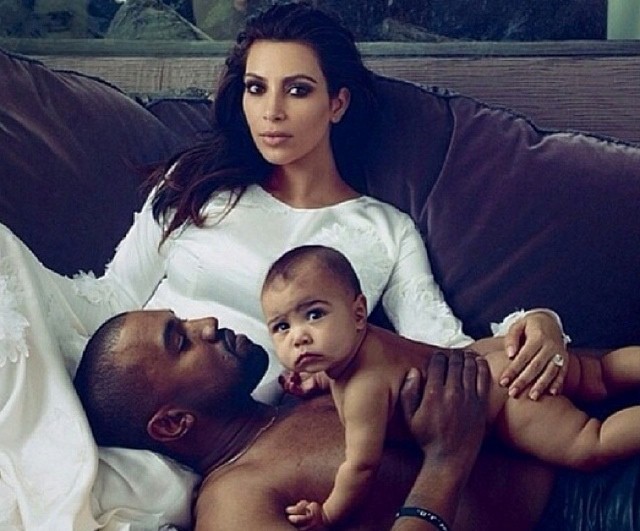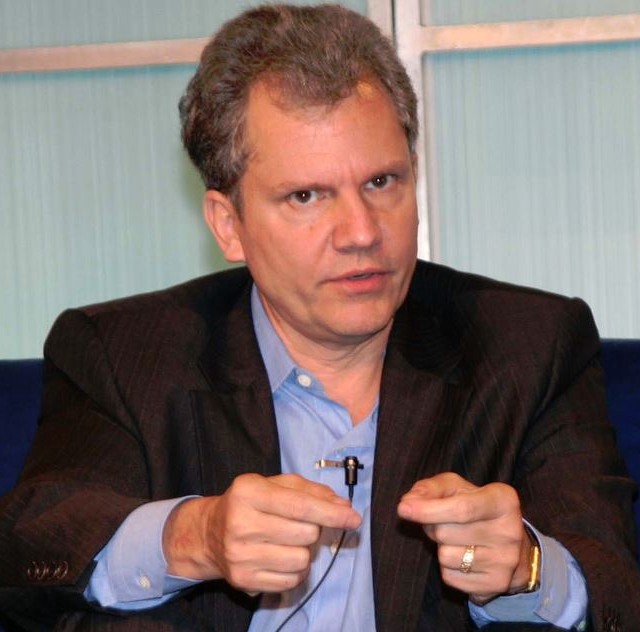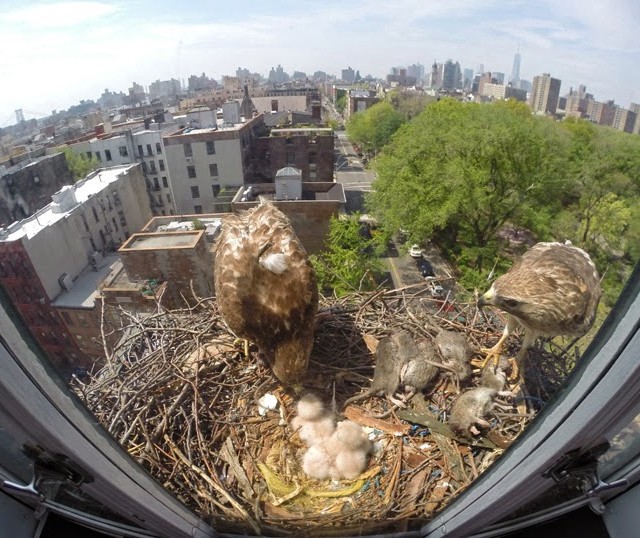New York City, May 15, 2014

★ There was mist out the window, then fine rain on the glass. The air was soggy and stayed that way after the rain had stopped. Taxis were hard to hunt, and curbside puddles menaced the best hunting spots. The top of the Time Warner Center remained fogbound. The Park was a green fluffy mass, with the crawling traffic of the traverse threading through it. The atmosphere was somewhere between clammy and stifling. Afternoon grew brighter and the air grew less and less breathable, till the air conditioner took over inside and the sun retreated again outside. A dark rat scurried along the pale traces of evaporated water in the rail bed at Lafayette. Uptown, at 59th Street, the 1 train bed was still wet, a low-tide muck of cigarette butts.
History Will Forgive Kim Kardashian
by Emily Greenhouse

Death jostled our usual holiday traditions, so my family spent last Thanksgiving with friends in Hastings-on-Hudson. I was seated at the kids’ table, millennials edition, which naturally meant an hour-long tangle of a conversation about Kanye West. I announced that I think of Kanye as a musical genius, but added that he struck me as something of a megalomaniac, given his remark to the Times, “I got the answers. I understand culture. I am the nucleus.” The young man sitting beside me, lanky and exquisite and recently out of Middlebury, took umbrage. Kanye, he insisted, spoke publicly about feeling barred from the highest level of our cultural institutions. Dismissing him as one splinter less than fully sane — failing to grasp or grant his full prowess — made me part of the problem. My comment was “raced,” he said.
On his “Yeezus” Tour, Kanye has denounced, again and again, what he sees as the fashion industry’s racism; his rallying cry is that the industry has stifled the pursuit of his grand ambitions and tried to tell him where he can and cannot go. In Las Vegas, last October, he said:
“They didn’t let us in the fashion shows. That’s what you don’t realize. We were in there like… just like my momma was when she was 6 years old getting arrested at the sit-ins. My momma was raised in the era when clean water was only served to the fairer skin. Doing clothes you would’ve thought I had help, but they wasn’t satisfied unless I picked the cotton myself.”
In a discussion with Bret Easton Ellis last November, Kanye said, “I kind of saw that side of what it was, as a creative, to be free, the parallel to the main character in Twelve Years a Slave. When it was taken away from me, it felt like what it felt like as a creative to be enslaved.”
Considering his anger and his desire to break into traditional, and traditionally white, institutions of cultural prestige — discussion of art-collecting in hip hop has not gone unnoticed — many have wondered about his choice for a partner in Kim Kardashian. Kardashian rose to prominence through a sex tape with the musician Ray J, and used her fame and selfies — where duck lips and derrieres reign — to catapult into reality stardom with the show “Keeping Up With the Kardashians.” The series, now on its ninth season, focuses on Kim and her sisters Kourtney and Khloé, their mother Kris, and other family members. Before the fifth season aired, the fashion personality Tim Gunn articulated the disdain of the crowd currently seeking to keep the show out of the Hamptons when he commented on Kim’s “vulgar” look: “It has a cheapness and a tawdriness.” The Kardashians, Gunn said, “have an absence of taste and I don’t think that that should be perpetuated.”
Kim and Kanye are engaged to be married (in Paris — no, Florence), and have a daughter, North, who was born last June. Whether or not you agree with Gunn’s view, Kanye’s alliance with Kim, weighed against his wish to be seen as a tastemaker on par with the likes of Ralph Lauren, startles. He is glaringly self-serious; she seems like the least serious of all American dreamers. But it just might be possible that her unseriousness is beside the point. Kardashian may have no recognizable talent, at least in our dull and traditional understanding of the word, but her every move makes waves, and money. Whether her wealth or fame came first is a chicken or the egg conundrum; they’re there, and they give her power, which gives her clout. Very quietly — so quietly you may not have noticed, beneath the loud clothes and glamour shots — Kim has deployed her branding savvy to push herself, and Kanye too, toward a seat of cultural prestige. These days, she’s even speaking more like the culturally prestigious. And the institutions — brands — of traditional power are starting to take note. In the age of Instagram, her popularity makes it difficult for certain doors to stay closed to her.
In some ways, Kardashian’s relationship with politics is a case study of what Kanye has faced. When Obama publicly endorsed same-sex marriage, in 2012, Kardashian took to her blog (and her Twitter page, and a press release), to celebrate:
Wow… I just heard that President Obama has officially announced that he supports gay marriage!! This is such a huge step forward in our country’s fight for civil rights and I hope that today this will give hope to so many young people across the country. We’ve never had a president so supportive of the lesbian, gay, bisexual and transgender community, and today I am proud to be an American!! I’m so happy that our country is making history and moving forward. No more living in the past!”
That same year, Kardashian reportedly approached the President repeatedly to campaign for his re-election bid. Each time, she was rebuffed. A source told Radar, echoing Tim Gunn’s earlier remarks, “They wanted nothing to do with her… Kim is political poison. Having her involved in a political event or with a candidate is the last thing people who are serious about getting elected want.” Nonetheless, Kim skipped “the bulk of Fashion Week” that fall to attend the Democratic National Convention in Charlotte, where she hosted an official afterparty.
It wasn’t enough to get Obama, the following summer, to avoid a dig at Kimye in an interview with Amazon. While recollecting his childhood, the president said, “I don’t think people went around saying to themselves: ‘I need to have a 10,000 square foot house.’ We weren’t exposed to things we didn’t have in the same way kids these days are. There was not that window into the lifestyles of the rich and famous. Kids weren’t monitoring every day what Kim Kardashian was wearing, or where Kanye West was going on vacation, and thinking that somehow that was the mark of success.”
Since then, Kim has come out for another candidate: the independent Marianne Williamson, a New Age guru who also counts Dennis Kucinich and Alanis Morisette on her side in the race for House seat for the California District 33. Four weeks ago, Kim posted on Instagram that she “went to hear @mariannewilliamson speak the other night w @kourtneykardash & @rachel_roy. Very inspiring! To learn more about her go to MarianneForCongress.com #vote #june3rd.” Her participation caused The Daily Mail, New York Magazine, and E! to cover the campaign.
Meanwhile, Kim has been sounding more and more like the enlightened punditry, or at least like the ladies who lunch at Cipriani’s for causes. The other week, days before her first Mother’s Day as a mom, Kardashian took to her blog to note what was “On My Mind.” “I never knew how much being a mom would change me,” she began. “It’s a beautiful thing to feel and experience so much more, but with that beauty comes a flip side — seeing through my daughter’s eyes the side of life that isn’t always so pretty.” She went on:
To be honest, before I had North, I never really gave racism or discrimination a lot of thought. It is obviously a topic that Kanye is passionate about, but I guess it was easier for me to believe that it was someone else’s battle. But recently, I’ve read and personally experienced some incidents that have sickened me and made me take notice. I realize that racism and discrimination are still alive, and just as hateful and deadly as they ever have been.
I feel a responsibility as a mother, a public figure, a human being, to do what I can to make sure that not only my child, but all children, don’t have to grow up in a world where they are judged by the color of their skin, or their gender, or their sexual orientation. I want my daughter growing up in a world where love for one another is the most important thing.
So the first step I’m taking is to stop pretending like this isn’t my issue or my problem, because it is, it’s everyone’s… because the California teenager who was harassed and killed by his classmates for being gay, the teenage blogger in Pakistan who was shot on her school bus for speaking out in favor of women’s rights, the boy in Florida who was wrongly accused of committing a crime and ultimately killed because of the color of his skin, they are all someone’s son and someone’s daughter and it is our responsibility to give them a voice and speak out for those who can’t and hopefully in the process, ensure that hate is something our children never have to see.
It does strain credibility, somewhat, that a thirty-three year old woman of color with Kardashian’s exposure and experience could have come this far without taking notice. She is a woman, of an unmistakable klatch (capital K?) of women. She is of Armenian heritage, and aware of the national history that entails. On April 24, she wrote, “April 24,1915 it was 99 years ago today 1.5 million Armenians were killed in a massacre. Let’s not stay in denial because it happened! Let’s recognize it!” She has discussed sexuality on her show, “exploring” whether her close friend Jonathan Cheban might be gay. She has dated men of a number of different races, including a number of high profile African-American men, and faced a particularly ugly kind of “slut shaming” for it. Her late father, Robert Kardashian, was among O.J. Simpson’s closest friends, as well as his defense attorney. (According to the Times, “Mr. Simpson stayed at Mr. Kardashian’s home in the days after Mr. Simpson’s former wife Nicole Brown Simpson and her friend Ronald L. Goldman were stabbed to death in 1994.”) Kim’s parents had divorced by then, but she could hardly have avoided knowing about one of the most racially charged criminal cases of all time. It’s difficult to imagine how she could have “never really [given] racism or discrimination a lot of thought,” when gender and race biases have been a part of her life — and, it must be said, class bias. The media, from the fore, have tarred her and her family as hopelessly tacky and nouveau riche; the country of WASP heritage loves to loathe a parvenu.
But it’s clear now that she is ascending in the eyes of the establishment, if only due to her overwhelming popularity: She and Kanye, and all of their millions of followers, had the might and the clout to make them the first interracial couple on the cover of Vogue. Now she’s raising awareness for the kidnapped girls in Nigeria, sitting with a one-hundred-year-old survivor of the Armenian genocide at a gala for the USC Shoah foundation and writing of our responsibility to create a world where little baby North won’t be judged by the color of her skin, her gender, or her sexual orientation. Kim has won over the fashion bible and its queen impresario, Anna Wintour — who has herself charmed, even conquered, the Obamas — begging the question: how much longer will the president keep her at bay? Why not, at least, get her to do an Obamacare ad? She’s the most-watched woman in America.
Given Kanye’s wish to access the highbrow demi-monde, Kim may really be The One. Time will tell, but the light of history may be as kind to her as the Instagram filters she uses. Already, I’m thinking my Thanskgiving dinner companion may be right: who am I to mock Kanye’s superlative claim to culture, when he’s tethering himself to a woman who can seemingly will herself anywhere?
Emily Greenhouse works at the New Yorker. She and Kanye West once discussed space programs in a drill hall. Photo via
A Poem by Max Winter
by Mark Bibbins, Editor
Ebenezer Makes a Prediction
The light goes on
The light goes off
A man sells a banana
A man sells a pear
The weather is fair today
Tomorrow it might not be so fair
You are singing
You are eating
You are disrobing
You are sleeping
The world is turning
The world is drying up
It is forgetting
It is remembering
There is a small beep
After the beep is silence
I am speaking
I am not speaking
I am raising
I am lowering
I am loving
I am not loving
I am not hating
I am described easily
I am evading description
A lie is told
A lie is recounted
In the retelling
a lie turns
into another lie
There is a crunch on the gravel
There is a sound in the wall
There is a cool spell after a hot spell
The opposite happens
The opposite of that happens
We notice
They don’t notice
It is understood
It is incomprehensible
It is blessed
It is doomed
We put on our little shoes
We buckle our collars
We go to work
There is no work
There is a problem with the bank
There is no problem with the bank
Everything is fine
Everything is terrible
I say it is
I say nothing
The boat enters the harbor
The boat sails north
The fog enters
The fog leaves
The horn sounds
The sound is scratchy
On the recording
We have remaining
But the sound is true
It is yes true
You cannot take it away
You have it in your hand
Max Winter is the author of Walking Among Them (Subpress, 2013) and The Pictures (Tarpaulin Sky Press, 2007). He co-edits the press Solid Objects.
You will find more poems here. You may contact the editor at poems@theawl.com.
Pinch Sulzberger, Fire Yourself Today
by Alex Pareene

On Wednesday, Arthur Ochs Sulzberger, Jr., publisher of the New York Times and chairman of The New York Times Company, mystified many of his employees by announcing that he had just fired Jill Abramson, who had been the paper’s executive editor since 2011. He didn’t explain why, and declined to substantively answer questions on the subject posed by the journalists he employs.
So: Sulzberger unceremoniously dispatches the first female head editor of the most important and prestigious newspaper in the world without explanation. Prior former editors, including the one who was there during the troubles with plagiarism and fabrication and war-mongering backed by trumped-up intelligence from disreputable sources, received gracious, dignity-preserving send-offs. (In fact, the one who was there during all the troubles got a moose.) Sulzberger then sort of sits there looking like an idiot while other outlets report that Abramson’s firing came shortly after she complained that her compensation was less than that of her immediate male predecessor.
This isn’t a piece about whether or not Jill Abramson was a good or a bad editor, or what led her to be unceremoniously axed this week. I don’t work for the Times, I don’t personally know any of the players involved, and I don’t pretend to know What Actually Happened. I am just a guy who makes fun of Times opinion columnists and does the crossword (Sundays through Thursdays). This is a piece about how the actual act of the axing became a P.R. disaster of nearly Bundy Ranchian proportions, thanks to the man who inherited the paper from his father, who inherited it from his father, who inherited it from his father-in-law, the last man in this chain of publishers who had to do anything resembling work to earn the position.
Arthur Ochs Sulzberger, Jr. is sometimes referred to as “Pinch,” a mocking variation of his father’s nickname, “Punch” (probably more often by media writers looking to sound knowing than by normal humans he knows). It is a mocking nickname because almost no one who comes into contact with Sulzberger has any respect for him, as a businessman or publisher or intellect. Years ago he was undeservedly handed what was then a great prize. Now he is responsible for preserving that prize in a recognizable form for the future. It is just really, really clear that he is not up to the task.
When the media reporter writes Times Kremlinology, it is customary to refer to the mood of The Newsroom as an undifferentiated whole, as in “It’s not that Abramson was adored in the newsroom,” or “Abramson has become a source of widespread frustration and anxiety within the Times newsroom.” Most of the time, we hear what The Newsroom thinks of its editors. Usually they are annoyed with their editors, because otherwise media reporters wouldn’t be writing media reporting about it. Few bother to measure the newsroom’s feelings about the person who’s really in charge. This is, I think, because the answer would just be too predictable to be noteworthy. Does anyone imagine that Arthur Sulzberger, Jr. has the respect of The Newsroom?
Times journalists think of the boss (correctly) as a dilettante and a flake, whose ignorance and insecurity leave him vulnerable to scammy corporate gurus and management fads. Sulzberger would probably say, as I’m sure he did to Abramson on multiple occasions, that Times journalists are too pretentious and idealistic to understand what it will take to make the New York Times work as a business in the 21st Century. But I find it hard to believe that the business side at the Times has any more respect for Sulzberger — and his flailing, transparently desperate attempts to make the business work — than the supposedly lofty-minded newsroom veterans do.
Arthur Sulzberger is in over his head. He’s clearly not up to the challenge of being the publisher of the nation’s last newspaper during the newspaper extinction era.
In some accounts of the Abramson firing, the last straw was an “innovation report” prepared, at Sulzberger’s request, by his son, Arthur Gregg Sulzberger, a reporter at the paper. The report describes the Times as existentially endangered, and unable to compete with nimbler digital journalism startups. The idea is that Abramson was unable to steer the Times toward its glorious digital future, and had to go. (I picture Joseph Cotten in stagey old-man makeup telling a faceless media reporter: “Well, Pinch and I had a disagreement about social. I suppose Pinch died without ever truly having a social strat…”)
The report essentially identifies a set of tech-related problems that need to be addressed, and then packages those problems with a set of ideological recommendations to change the “culture” of the Times. The paper needs to improve the backend, and needs better tools for creating digital content, the report says. OK, sure, that sounds good! But also:
“The very first step … should be a deliberate push to abandon our current metaphors of choice — ‘The Wall’ and ‘Church and State’ — which project an enduring need for division. Increased collaboration, done right, does not present any threat to our values of journalistic independence,” the report says.
Ah, yes, you mean this kind of “innovation.” The report also suggests “TED-style talks” because everyone and everything in the 21st century is terrible and stupid.
It’s probably true that the Times is full of print-era dinosaurs in positions of authority. But… so what? The product is generally good. Not only that, but the Times is in the enviable position of being the last national newspaper left standing. It doesn’t need to worry about Vox.com. It doesn’t need to sweat losing Nate Silver. They can hire another one. It is the business side’s responsibility to sell that product. It is Arthur Sulzberger, Jr.’s job to ensure the survival of this institution without sacrificing the things that actually make it valuable. The answer is not TED talks or branded content that looks deceptively like non-branded content.
But if the end goal is to break down the wall between business and editorial, and to make Times reporters waste as much time on bullshit marketing activities as “digital natives” do, then the report is a masterstroke. A.G. Sulzberger might be a lot cleverer than his father. (I’m not the only one who thinks so!) I’m sure the business side can’t wait for his ascension.
Alex Pareene is a digital native and the executive editor of a mysterious secret project at First Look Media. Photo by JD Lasica.
Fun With New York Times Numbers
For all the cloudiness over the really real reasons that Jill Abramson was fired — because she was “brusque”! because she tried to secretly hire another co-managing editor to run digital! because her Times tattoo isn’t large enough! not sexism! — there is at least one set of cold, hard data:
As executive editor, Abramson’s starting salary in 2011 was $475,000, compared to Keller’s salary that year, $559,000. Her salary was raised to $503,000, and — only after she protested — was raised again to $525,000. She learned that her salary as managing editor, $398,000, was less than that of the male managing editor for news operations, John Geddes. She also learned that her salary as Washington bureau chief, from 2000 to 2003, was a hundred thousand dollars less than that of her successor in that position, Phil Taubman. (Murphy would say only that Abramson’s compensation was “broadly comparable” to that of Taubman and Geddes.)
To say nothing of inflation. So yes, it is mysterious that the highest ranking woman in print journalism initially making nearly a hundred thousand dollars less than her male predecessor has become the cause célèbre of media.
Where Do Rats Go When They Die?

When rats die, they go to rat heaven or rat hell. The terminal stations in human afterlives do not have physical locations but do have common physical associations; in the rat afterlife, these associations are both based in reality and inverted. Rat heaven is below, in the subway muck. Rat hell is above, in the nest of a hawk.
Here is something I had not considered: That in Manhattan, and probably Queens and Brooklyn and the Bronx, live hawks. Hawks in windows and hawks on roofs. Big hawks, abducting rodents and laying eggs. This week, hatching them! Nor had I imagined the existence of a network of websites and cameras, via EV Grieve, dedicated to documenting these birds. Look up! (Photo by Francois Portmann)
